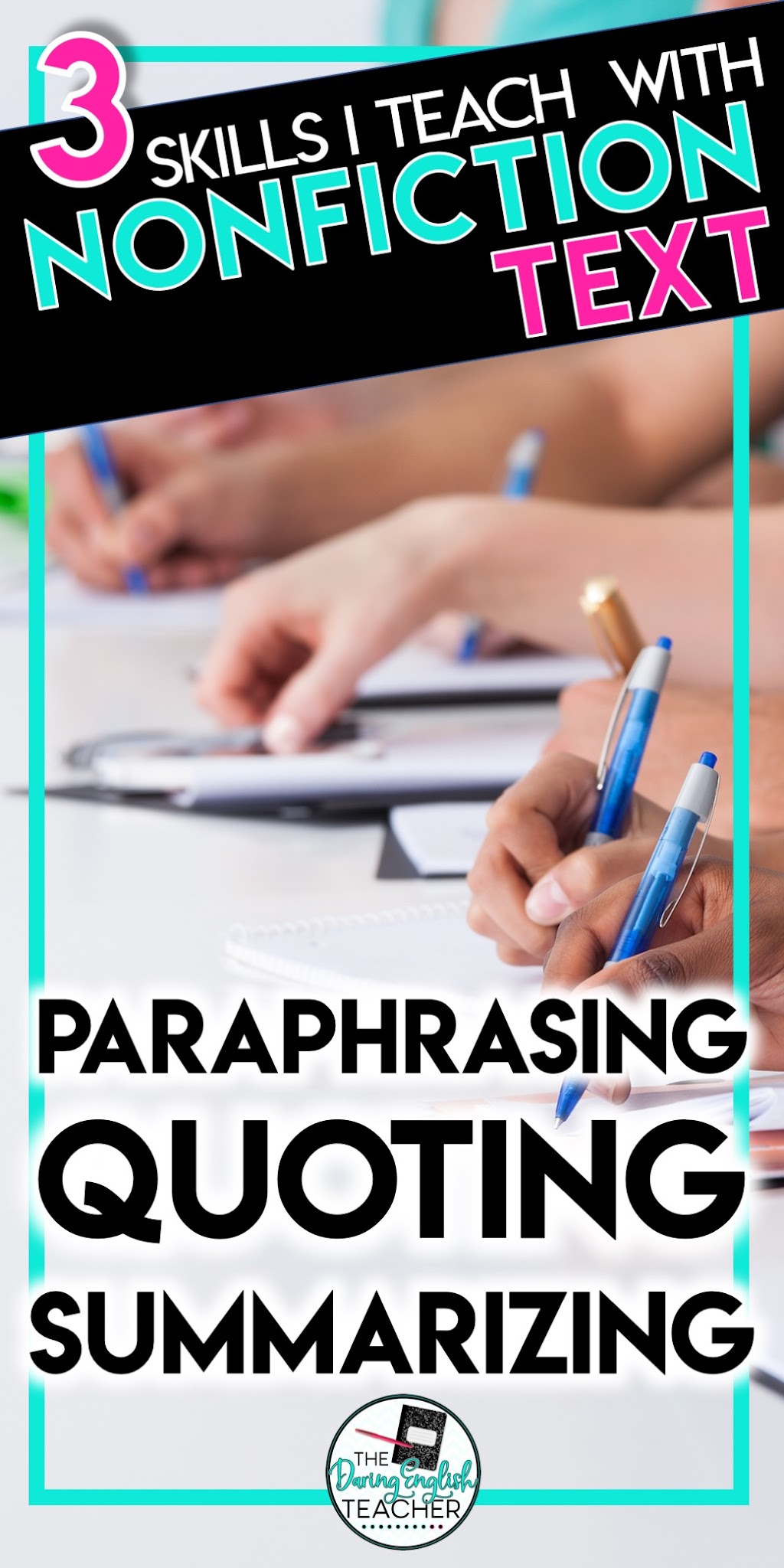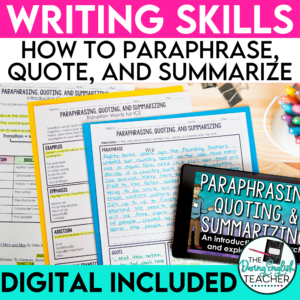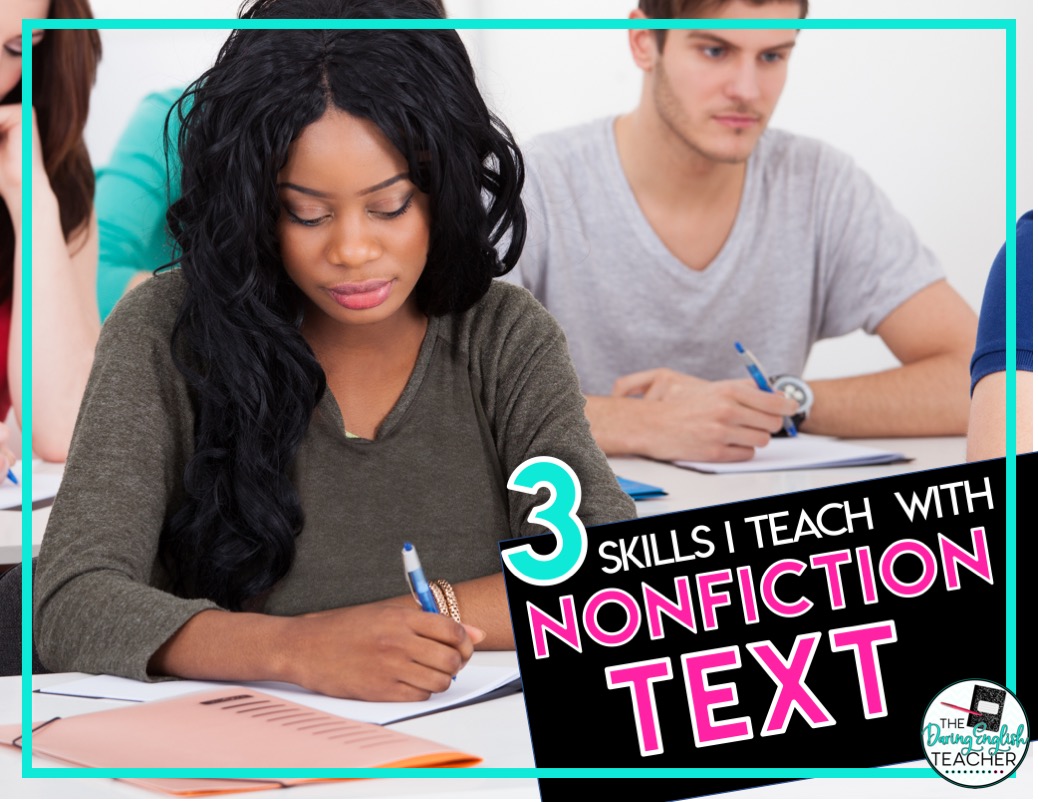I like to incorporate a lot of nonfiction in my curriculum. While I love fiction and make sure I include it in my instruction, I also firmly believe that studying, analyzing, and writing about nonfiction is vitally essential for today’s learners.
That is what I always place an emphasis on these skills when teaching nonfiction text in the high school English classroom.
When I teach argumentation and nonfiction texts in my classroom, there are three skills that I intentionally teach toward the beginning of the unit: paraphrasing, quoting, and summarizing. While I believe that teaching specific rhetorical devices and strategies are important, I save those lessons for when my students are able to correctly paraphrase, quote, and summarize any piece of text.
Teaching Nonfiction: 3 Skills I Teach With Nonfiction Text
Teaching Nonfiction: Paraphrasing 
In my opinion, I believe that paraphrasing text is a bit easier than summarizing text since it is essentially rewriting the entire text in one’s own words. One of the pitfalls in which most students fall victim to is failing to properly cite the paraphrased text.
This is because so many students assume that just because the text is in their own words that it is theirs, and this is not true.
When I teach paraphrasing, I place great emphasis on the need to properly cite their research and the work they are paraphrasing to maintain credibility and avoid plagiarism.
Teaching Nonfiction: Summarizing
When I teach summarizing, I place an emphasis on finding the main idea and supporting details in the text. When students summarize an article for me, they should always include the article title, author, the main message, and how the author delivers that particular message.
Teaching Nonfiction: Quoting
One of the most challenging writing skills for students to master is how to properly embed quotations in their writing.
When I teach students to embed quotes (whether from fiction or nonfiction) in their writing, I focus on having the students introduce the quote in their own words with a transition word or phrase and contextual information, and then complete the sentence with a quote that grammatically fits within the sentence.
I tell my students their quotes should be seamlessly written into their papers, and that they should never begin a sentence with a quote.
When students know how to properly paraphrase, summarize, and quote text, they will have the skill set necessary to take rhetorical and textual analysis to a deeper and more meaningful level. Some great sites to access nonfiction text include CommonLit.org, NewsELA.com, and Listenwise.com.
Paraphrasing, Quoting, and Summarizing: A Unit on Informative Writing

Help your students improve their writing by focusing on three key skills with this Paraphrasing, Quoting, and Summarizing teaching unit. This unit that teaches students how to paraphrase, quote, and summarize text in their own writing will help students add more variety to their essays. In this informational writing mini-unit, your students will learn the differences between paraphrasing, quoting, and summarizing, and when to use each one in their writing.
Teachers like you say…
⭐️⭐️⭐️⭐️⭐️ Extremely Satisfied
“The “Paraphrasing, Quoting, and Summarizing: A Unit on Informative Writing” has been an invaluable addition to my curriculum. This unit offers a comprehensive and structured approach to developing students’ skills in paraphrasing, quoting, and summarizing—essential components of informative writing. The well-designed lessons and practical exercises effectively guide students through the nuances of these critical skills, promoting a deeper understanding of how to integrate external sources into their writing. As an English teacher, I appreciate the clarity and effectiveness of this unit in fostering not only technical writing abilities but also a heightened awareness of proper citation and source integration. Highly recommended for its practicality and relevance in preparing students for informative writing tasks.”
⭐️⭐️⭐️⭐️⭐️ Extremely Satisfied
“There is much more than I anticipated in this resource and found myself needing to spread it out over three days of 55 minute classes. I used it to review what I thought students knew and realized we needed almost a day to practice paraphrase alone. I love being able to print supplemental texts from the presentation for students to write on and the quiz at the end of the presentation. To conclude we used our own reading already completed in class with the handouts, practicing the strategies specifically, before heading into MLA review and our first formal writing. Kids can return to the handouts, and I can reteach as needed through the year. Great product!”
⭐️⭐️⭐️⭐️⭐️ Extremely Satisfied
“This resource was so helpful before starting our informational writing unit. I realized many of my students did not know the difference between the three and were having trouble doing it for their essays. This broke it down for them and helped them use it for their essays/short responses since it included sentence stems. Thank you!”


